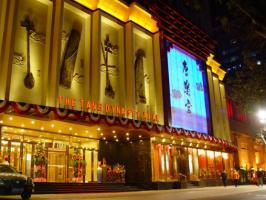Join-in Group Silk Road China Tours
About Us | Contact us | Tourist Map | Hotels | Feedback
China Silk Road Travel Tips

Overview:Silk Road China travel tips and trip advice on facts, people, history, culture in in Shaanxi Xian, Gansu Dunhuang, Ningxia, Xinjiang Kashgar, Turpan, Urumqi and more.
Historically, the Silk Road is an ancient international trade passage-way from Xian in central China to Mediterranean area that has connected the civilizations and thus promoted the multi-interchange between East and West. The Silk Routes pass through a variety of landform such as immense Gobi deserts, vast grassland, high pleatau, alpine mountains of Tianshan, Karakurum, Himalayans and others.
What is more important that there are 13 local ethnic groups settel down for a long history and other 30 ethnic minorities scatter over the area. They believe in Islam, Lamaism (Tibetan Buddhism), Buddhism, Christianity, Catholicism, Eastern Orthodox, Shamanism and more religions.
What are the top attractions must see on the Silk Road China.
Xian
Terracotta Army Warriors (UNESCO heritage site)
The Ancient City Wall
Tang Dynasty Dance Show
Lanzhou
Xiahe Sangke Grasslands
Labrang Monastery
Jiayuguan
Han Dynasty Great Wall
Dunhuang
Dunhuang Mogao Caves (UNESCO heritage site)
Sand Eco Mountain & Crescent Lake
Urumqi
Tianshan Mountain No. 1 Glacier & Heavely Lake (UNESCO heritage site)
Xinjiang Uygur Regional Museum
Turpan Depression
Karez Channels
Grape Valley
Jiaohe Ancient Ruins
Kashgar
Sunday Bazaar
Id Kah Mosque
Abakh Khoja Tomb
Silk Road Travel Packing Tips:
Due to the diversified geography, dry, sandy, windy and changeable climate, visitors are supposed to imitate the locals by staying in the shade around midday in extremely hot summer; coat keeping warm at raw and severe cold night; bring the items below:
1. In deference to Muslim sensibilities, long pants or skins should be worn by both sexes whenever possible in sunny, windy and sandy days.
2. Solid and comfortable Shoes for hiking and walking most of the time although there are some spots where camel rides are required.; even in the summer it is advisable to have thick-soled shoes, for the ground temperature can get extremely hot, especially at sites in the desert. High-cut shoes with hard tread, Sports shoes or low-heeled shoes are your best bet.
3. Enough clothes to keep you warm. Woollen layers, a thick coat made of down or gortex, and warm boots are essential protection against the piercing winds and cold. Enough clothes to keep you warm. Most of the time, you only need to wear short pants and shirts with short-sleeves. We suggest that you wear jeans in mountainous places where the weather might become a bit cool. It is always advisable that you bring extra clothes and a jacket just in case the weather becomes chilly.
4. Hats, sunglasses, sun block and lip balm are essential to protect you from sun and windburns.
5. Scarves, or some protective material, are a must when the weather becomes windy to protect you from sand (especially in desert areas) and from strong ultraviolet radiation and strong sand storms when the weather becomes windy.
6. Enough water to avoid dehydration.
A backpack is a good choice to put all these necessities (other than clothes): rain gear, water, camera, electric torch, maps, medicines etc.Travellers should also be prepared for dust storms, especially in Turpan, which often begin in the early afternoon and last for several hours: abrasive, blasting sands whipped up by strong winds, bringing all activity to a halt. The dust is particularly bad news for your camera. (Fuji colour film is widely available, but bring your own black and white.) It is important to carry a good torch, especially when visiting unlit Buddhist caves. A sturdy pair of sunglasses and water bottle are also highly recommended.
Travel Tips for dealing with locals
1. Remember to follow the local relegious customs and avoid to be a mosque intruder and the like;
2. Attention! When you want to bargain with someone, it means you decide to buy something; no decision, no bargain there;
3. Mostly, kilogram are used on market transaction by locals, something different from the rest area of China;
4. Identity card is a must when go around here and there in Xinjiang;
5. Know that The children undertand and say Chinese or English better than adults when you ask for directions in Xinjiang;
6. Remind that the locals follow Xinjiang Urumqi Time (UTC+6) at all works of life, except the schedules of flights, trains use Beijing Time (UTC+8); Officially, Xinjiang is on the same time zone as the rest of China, Beijing Time (UTC+8). However, being roughly two time zones west of the capital, some residents follow their own unofficial Xinjiang Time (UTC+6). The division follows ethnic lines, with Han tending to use Beijing Time and Uighurs tending to use Xinjiang Time; this is seen as a form of resistance to the central government. Regardless of the ethnicity of their proprietors, most businesses and schools open and close according to Xinjiang time, i.e. two hours later than their equivalents in other regions of China.
Stay safe
Theft: Xinjiang is home to a lively bazaar culture where anything and everything is traded. But hordes of people crammed into confined spaces also present a prime opportunity for pickpockets, who often operate in teams and can be very efficient at what they do. Be very careful with your valuables when you are out and about. As a foreign traveller you are a prime target.
Counterfeit notes: Be careful when paying with 100 yuan notes in smaller restaurants or shops. The owner may switch the note with a counterfeit one and claim that you gave him/her a fake note. You should also check your notes when you are returned your hotel deposit.


